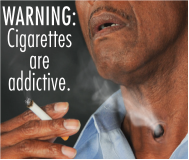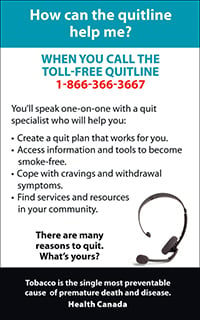Tobacco use remains the leading cause of preventable death in the United States [1]. To reduce tobacco’s impact on public health, the U.S. Food and Drug Administration (FDA) was given regulatory authority over tobacco products in the Family Smoking Prevention and Tobacco Control Act of 2009 [2]. The act’s mandate to the FDA included selection of “color graphics depicting the negative health consequences of smoking” to accompany nine different text messages for health warning labels (HWLs) that will cover 50 percent of the front and back of cigarette packages. The messages consist of the word “WARNING” paired with one of the following: “Cigarettes are addictive,” “Tobacco smoke can harm your children,” “Cigarettes cause fatal lung disease,” “Cigarettes cause cancer,” “Cigarettes cause strokes and heart disease,” “Smoking during pregnancy can harm your baby,” “Smoking can kill you,” and “Tobacco smoke causes fatal lung disease in nonsmokers.” This policy is consistent with recommendations by the World Health Organization Framework Convention on Tobacco Control (WHO-FCTC) [3, 4], the world’s first global health treaty. As of 2012, 56 countries had implemented prominent pictorial HWLs on cigarette packs, and seven more countries are scheduled to do so in 2013 [5]. The U.S. was to join these countries in 2012, but tobacco industry litigation has delayed implementation of this key tobacco control policy.
The tobacco industry has argued that the images the FDA selected for HWLs violate their First Amendment rights by compelling them to engage in speech that is against their interests [6]. The industry claimed that many of the selected images were designed to provoke emotional responses that go beyond the goal of informing consumers about the consequences of tobacco use [6]. The Washington, D.C. District Court effectively halted implementation of pictorial HWLs in February 2012 [6], judging the industry’s argument to have merit, a judgment that was upheld by the U.S. Court of Appeals in August 2012 [7]. In March 2013, the FDA decided not to appeal the case to the U.S. Supreme Court [8]. Nevertheless, in April 2013, the U.S. Supreme Court let stand a prior appellate court ruling that clears the way for the FDA to propose a new set of images to accompany the already-legislated textual content of the HWLs [9]. These new pictorial HWLs will most likely need to overcome additional legal challenges from the tobacco industry. This essay reviews the primary tobacco industry arguments and the public health arguments against the industry, including those from the ruling and dissenting opinions in the appeals court case, while reflecting on existing scientific evidence and ethical considerations raised by this issue.
Pictorial Health Warning Labels
The inclusion of textual HWLs on the side of cigarette packs to warn consumers of the health risks associated with smoking began in the U.S. in 1965 [10]. The content and format of these warning labels was last revised in 1984 [11]. Evidence shows that these warnings are unnoticed by consumers and they have failed to convey relevant information in an effective way. According to the Institute of Medicine, “the current warnings are inadequate even when measured against an informed choice standard, but they are woefully deficient when evaluated in terms of proper public health criteria” [12]. The tobacco companies do not challenge the factual accuracy of the text statements proposed for the new HWLs [7], nor could they reasonably do so, given the scientific consensus that tobacco products are dangerous and a leading cause of many diseases. The main legal challenges in this case revolve around the graphic images selected by the FDA to accompany the factually accurate text statements.
In determining the legal framework against which to judge the tobacco industry’s case, the U.S. Court of Appeals had to assess whether the pictorial HWLs that the FDA selected were “reasonably related to the State’s interest in preventing deception of consumers” [13]. Because the FDA did not design the pictorial HWLs to correct specific deceptive claims by the industry about their products, the appeals court viewed the FDA’s recommended HWLs as going beyond this goal and agreed with the tobacco industry contention that the HWLs aimed to discourage consumers from buying the company’s products. This narrow interpretation of the FDA’s role in correcting deceptive claims did not consider the long history of systematic tobacco industry campaigns to deceive consumers and regulators about the harms of tobacco and to enhance the addictiveness of their products [14, 15]. In 2012, the U.S. District Court for the District of Columbia upheld charges against the industry using the Racketeer Influenced and Corrupt Organizations (RICO) Act for proven “misstatements and acts of concealment and deception…made intentionally and deliberately…as part of a multi-faceted, sophisticated scheme to defraud” [16]. The government’s interest in implementing pictorial HWLs should be examined against this broad backdrop and long history of industry deceit.
Indeed, the dissenting opinion of the appeals court highlights the implications of this deceit by citing studies done between 2000 and 2007, which found that many current and potential smokers were not adequately informed about the range and magnitude of tobacco-related risks or about the addictive nature of tobacco use. In one survey, for example, 28 percent of smokers and 18 percent of non-smokers were not aware that smoking shortens one’s life [17], and a high proportion of consumers had inaccurate assessments of the fatality of smoking compared with other risks to which they were exposed, such as car accidents [17, 18]. Moreover, smokers generally did not fully understand the implications of tobacco addiction for quitting and underestimated their risk relative to other smokers and to nonsmokers [19].
This tendency to underestimate risks appears particularly pronounced in adolescents, who have been shown to express unrealistic optimism about their ability to quit smoking after they start smoking [18-20]. For example, only 3 percent of twelfth-grade daily smokers reported that they would still be smoking in 5 years, but 63 percent were daily smokers 7 to 9 years later [21]. The addictiveness of tobacco is clear when one considers that 40 percent of smokers try to quit in any particular year, and only 5 percent succeed [18]. Misperceptions of the addictiveness of smoking and its harms are particularly tragic given that smoking remains the leading cause of preventable death in the US, causing smokers to die 10 years earlier than nonsmokers [22]. HWLs are a cheap means of delivering important health information on the addictiveness and dangers of smoking to consumers and potential consumers.
The appeals court ruling did not view HWLs as a corrective to tobacco industry fraud, and therefore concluded that the FDA’s intent was to “encourage current smokers to quit and dissuade other consumers from ever buying cigarettes” [23]. They highlighted the lack of scientific evidence for a substantial impact of pictorial HWLs on smoking prevalence. Indeed, scientific study of pictorial HWL policy effects is complicated by the simultaneous implementation of pictorial HWLs with other tobacco control measures, all of which could help explain subsequent declines in consumption. Existing evidence for the population impact of pictorial HWLs on consumption suggests a relatively small effect size, but it is in the direction that favors public health [24]. Relatively small behavioral effects are not unexpected from interventions like this, but their impact can be significant because of their broad reach, regularly exposing all smokers.
The appeals court indicated that the broader goal of reducing smoking supersedes the FDA’s stated “primary goal, which is to effectively convey the negative health consequences of smoking on cigarette packages and in advertisements” [25]. Hence, the appeals court did not seriously consider consumer misperceptions of smoking-related risks, the tobacco industry’s role in perpetuating these misperceptions, or the evidence showing how pictorial HWLs can increase consumer knowledge of smoking risks. Indeed, HWLs are a prominent source of health information for smokers and nonsmokers; they can increase health knowledge and perceptions of risk and can promote smoking cessation [26, 27]. Larger, more prominent warnings are more effective than smaller warnings, and warnings that contain pictures that illustrate the consequences of smoking are more likely than warnings with only text to capture the attention of consumers, to produce greater processing of the information, and to be remembered [27]. Moreover, graphic HWLs that elicit strong emotional reactions have been found to be more effective than more symbolic or abstract representations of risk [28-30]. It is the FDA’s goal to adopt HWLs that are most likely to promote changes in knowledge, attitudes, and behaviors, and the evidence suggests that large graphic HWLs work best.
Tobacco industry arguments against pictorial HWL content also hinged on whether the images were considered “purely factual and uncontroversial” [6, 7]. The industry argument about the need for more factual HWLs is grounded in their concern that the FDA analyzed consumers’ emotional responses to HWLs in order to select the most effective pictorial content [6, 7]. This allegation that the emotive quality of the images conflicts with the purpose of communicating facts is particularly hypocritical coming from an industry that has been at the forefront of using emotive, image-based advertising to persuade people to consume its products. Persuasive messages that effectively change beliefs, attitudes, and behaviors often involve arousing negative emotions [31, 32], and the most effective tobacco control campaigns employ this strategy [33, 34]. Although some of the graphic images the FDA selected may evoke emotional reactions, it is undisputed that smoking can cause the health consequences these images depict (see figure 1). The emotive quality of the selected images does not necessarily undermine the HWLs’ factual accuracy, but in selecting the next round of HWL imagery, the FDA will most likely need to strengthen arguments about the linkage between images and the text messages that they illustrate.
Figure 1. Example of FDA-proposed Pictorial Health Warning Label [35].

Information that Facilitates Smoking Cessation Efforts
One area of concern for the selection pictorial HWL content in the U.S. involves the inclusion of a toll-free phone number where smokers who want to quit can find help (i.e., “quitline”). Both the majority and dissenting opinions in the U.S. Court of Appeals highlighted how the inclusion of this “1-800-QUIT-NOW” quitline on pictorial HWLs went beyond the FDA’s mandate to disclose factual information about the health consequences of smoking. In other countries, pictorial HWLs that include such content have raised awareness about quitlines [36, 37] and increased the volume of calls they receive [38-41]. Indeed, pictorial HWLs that increase awareness of smoking-related dangers without providing behavioral recommendations or information to help with quitting violate basic principles of public health communication [42] while raising ethical concerns.
As public health communications, HWLs should provide members of the population with reasonable opportunities to pursue the behavior change needed to avoid the negative outcome [32]. Providing information on the addictiveness of tobacco and the harmfulness of smoking unaccompanied by cessation assistance information assumes that consumers have a free choice and personal responsibility to stop or avoid smoking or to pursue information on smoking cessation programs. However, nicotine addiction makes cessation extremely difficult, and when combined with the lack of knowledge about or access to cessation programs, smokers may blame themselves or their “weak” character for not quitting.
A further ethical concern associated with justice could be raised [32], inasmuch as socioeconomically disadvantaged populations, which have the highest rates of smoking, may have the least access to cessation programs [43]. Providing disadvantaged populations with information on free quitline services is crucial to advance the FDA’s interest in reducing smoking rates. If the inclusion of quitline information on cigarette package HWLs is considered beyond the FDA mandate, then alternative means of providing smokers with this information should be considered. In Canada, for example, all packs contain either “onserts” or leaflets that include quitline information and smoking cessation advice (see figure 2).
Figure 2. One of Eight “Onserts” Included in All Cigarette Packs Sold in Canada [44].

Conclusion
In its April 2013 decision, the U.S. Supreme Court cleared the way for the FDA to propose a new set of pictorial HWLs for inclusion on cigarette packages [9]. In so doing, it has implicitly signaled its recognition of the FDA’s mandate to inform consumers about the risks of tobacco products, and there is ample evidence to favor the efficacy of pictorial HWLs for achieving this goal. This policy measure is necessary to combat a long history of tobacco industry deceit about the magnitude and range of tobacco-related harms. Existing scientific evidence suggests that HWLs that graphically illustrate the harms of smoking should be considered for implementation in order to effectively inform consumers and would-be consumers about these risks.
References
- Centers for Disease Control and Prevention. Smoking-attributable mortality, years of potential life lost, and productivity losses--United States, 2000-2004. MMWR Morb Mortal Wkly Rep. 2008;57(45):1226-1228.
-
Waxman H. HR 1256-Family Smoking Prevention and Tobacco Control Act (2009). http://www.govtrack.us/congress/bills/111/hr1256/text. Accessed July 3, 2013.
-
World Health Organization. Framework Convention on Tobacco Control. Geneva, Switzerland: World Health Organization Tobacco Free Initiative; 2003. http://whqlibdoc.who.int/publications/2003/9241591013.pdf. Accessed July 3, 2013.
-
World Health Organization. Guidelines for implementation of Article 11 of the WHO Framework Convention on Tobacco Control (packaging and labelling of tobacco products) [2009]. http://www.who.int/fctc/guidelines/article_11.pdf. Accessed July 3, 2013.
-
Canadian Cancer Society. Cigarette package warning labels: International status report Ottawa, Canada: Canadian Cancer Society, 2012. Accessed July 3, 2013.
-
R.J. Reynolds Tobacco Company, et al. v Food & Drug Administration, et al., No. 11-1482 WL 653828 (February 29, 2012).
-
R.J. Reynolds Tobacco Company, et al. v Food & Drug Administration, et al., No. 11-5332, WL 1391191 (August 24, 2012). http://www.cadc.uscourts.gov/internet/opinions.nsf/4C0311C78EB11C5785257A64004EBFB5/$file/11-5332-1391191.pdf. Accessed July 3, 2013.
-
Dennis B. Government quits legal battle over graphic cigarette warnings. Washington Post. March 19, 2013. http://www.washingtonpost.com/national/health-science/government-quits-legal-battle-over-graphic-cigarette-warnings/2013/03/19/23053ccc-90d7-11e2-bdea-e32ad90da239_story.html. Accessed April 29, 2013.
-
Reinberg S. U.S. Supreme Court rejects tobacco industry challenge to new cigarette labeling. U.S. News. April 22, 2013. http://health.usnews.com/health-news/news/articles/2013/04/22/us-supreme-court-rejects-challenge-to-new-cigarette-labeling. Accessed April 29, 2013.
-
Federal Cigarette Labeling and Advertising Act of 1965, 79 Stat 282, Public Law 89-92:. http://www.gpo.gov/fdsys/pkg/STATUTE-79/pdf/STATUTE-79-Pg282.pdf. Accessed July 3, 2013.
-
Comprehensive Smoking Education Act of 1984, 98 Stat 2200, Pub Law 98-474. http://www.gpo.gov/fdsys/pkg/STATUTE-98/pdf/STATUTE-98-Pg2200.pdf. Accessed July 3, 2013.
-
Lynch BS, Bonnie RJ, eds; Institute of Medicine. Growing Up Tobacco Free: Preventing Nicotine Addiction in Children and Youths. Washington, DC: The National Academies Press; 1994:252.
-
R.J. Reynolds Tobacco Company, et al. v Food & Drug Administration, et al. (August), 13.
-
Eubanks S, Glantz SA. Bad Acts: The Racketeering Case Against the Tobacco Industry. Washington, DC: American Public Health Association; 2012.
-
Brandt AM. The Cigarette Century: The Rise, Fall, and Deadly Persistence of the Product that Defined America. New York: Basic Books; 2007.
-
United States v. Philip Morris USA, Inc., 787 F Supp 2d 68, 74-75 (2011).
-
Jamieson P, Romer D. What do young people think they know about the risks of smoking? In: Slovic P, ed. Smoking: Risk, Perception, and Policy. Thousand Oaks, CA: Sage; 2001:51-63.
-
Bonnie RJ, Stratton K, Wallace RB, eds; Institute of Medicine. Ending the Tobacco Problem: A Blueprint for the Nation. Washington, DC: The National Academies Press; 2007.
- Weinstein ND, Marcus SE, Moser RP. Smokers’ unrealistic optimism about their risk. Tobacco Control. 2005;1455-59.
- Arnett JJ. Optimistic bias in adolescent and adult smokers and nonsmokers. Addict Behav. 2000;25(4):625-632.
-
Johnston LD, O’Malley PM, Bachman JG, Schulenberg JE. Monitoring the Future National Results on Adolescent Drug Use: Overview of Key Findings, 2004. Bethesda, MD: National Institute on Drug Abuse; 2005. http://www.monitoringthefuture.org/pubs/monographs/overview2004.pdf. Accessed July 3, 2013.
- Jha P, Ramasundarahettige C, Landsman V, et al. 21st-century hazards of smoking and benefits of cessation in the United States. N Engl J Med. 2013;368(4):341-350.
-
R.J. Reynolds Tobacco Company, et al. v Food & Drug Administration, et al. (August), 23.
- Azagba S, Sharaf MF. The effect of graphic cigarette warning labels on smoking behavior: evidence from the Canadian experience. Nicotine Tob Res. 2013;15(3):708-717.
-
Food and Drug Administration, HHS. Required warnings for cigarette packages and advertisements: final rule. Fed Regist. 2-11;76(120):36628-36777.
- Borland R. Tobacco health warnings and smoking-related cognitions and behaviours. Addiction. 1997;92(11):1427-1435.
- Hammond D. Health warning messages on tobacco products: a review. Tobacco Control. 2011;20(5):327-
- Hammond D, Thrasher J, Reid JL, Driezen P, Boudreau C, Arillo-Santill�n EA. Perceived effectiveness of pictorial health warnings among Mexican youth and adults: a population-level intervention with potential to reduce tobacco-related inequities. Cancer Causes Control. 2012;23(Suppl 1):57-67.
- Thrasher JF, Carpenter MJ, Andrews JO, et al. Cigarette warning label policy alternatives and smoking-related health disparities. Am J Preventive Med. 2012;43(6):590-600.
- Thrasher J, Arillo-Santill�n E, Villalobos V, et al. Can pictorial warning labels on cigarette packages address smoking-related health disparities? Field experiments in Mexico to assess pictorial warning label content. Cancer Causes Control. 2012;23(Suppl 1):69-80.
- Witte K. The manipulative nature of health communication research. Am Behav Sci. 1994;38(2):285-293.
-
Guttman N. Public Health Communication Interventions: Values and Ethical Dilemmas. Thousand Oaks, CA: Sage Publications; 2000.
- Wakefield MA, Durkin S, Spittal MJ, et al. Impact of tobacco control policies and mass media campaigns on monthly adult smoking prevalence. Am J Public Health. 2008;98(8):1443-1450.
- Durkin S, Brennan E, Wakefield M. Mass media campaigns to promote smoking cessation among adults: an integrative review. Tobacco Control. 2012;21(2):127-138.
-
Food and Drug Administration. Overview: cigarette health warnings. Accessed April 29, 2013.
-
Thrasher J, P�rez-Hern�ndez R, Arillo-Santill�n E, Barrientos I. Hacia el consumo informado de tabaco en M�xico: Evaluaci�n de las advertencias con pictogramas a partir de una encuesta longitudinal en la poblaci�n fumadora [Towards informed consumption of tobacco in Mexico: Evaluation of pictorial warnings in a longitudinal survey of smokers]. Revista de Salud P�blica de M�xico. 2012;54:242-253.
- Thrasher JF, Murukutla N, P�rez-Hern�ndez R, et al. Linking mass media campaigns to pictorial warning labels on cigarette packages: a cross-sectional study to evaluate impacts among Mexican smokers. Tob Control. 2013;22(e1):e57-e65.
- Willemsen M, Simons C, Zeeman G. Impact of the new EU health warnings on the Dutch quit line. Tob Control. 2002;11(4):382-
- Miller CL, Hill DJ, Quester PG, Hiller JE. Impact on the Australian Quitline of new graphic cigarette pack warnings including the Quitline number. Tob Control. 2009;18(3):225-237.
- Wilson N, Li J, Hoek J, Edwards R, Peace J. Long-term benefit of increasing the prominence of a quitline number on cigarette packaging: 3 years of Quitline call data. N Z Med J. 2010;123(1321):109-111.
-
Cavalcante TM. Labelling and Packaging in Brazil. Geneva, Switzerland: Organizacion Mundial de Salud; 2003.
- Witte K, Allen M. A meta-analysis of fear appeals: implications for effective public health campaigns. Health Educ Behav. 2000;27(5):591-615.
- Garrett BE, Dube SR, Trosclair A, Caraballo RS, Pechacek TF. Cigarette smoking - United States, 1965-2008. MMWR Surveill Summ. 2011;60 Suppl109-113.
-
Health Canada. Tobacco product labeling. http://www.hc-sc.gc.ca/hc-ps/tobac-tabac/legislation/label-etiquette/index-eng.php. Accessed April 29, 2013.



